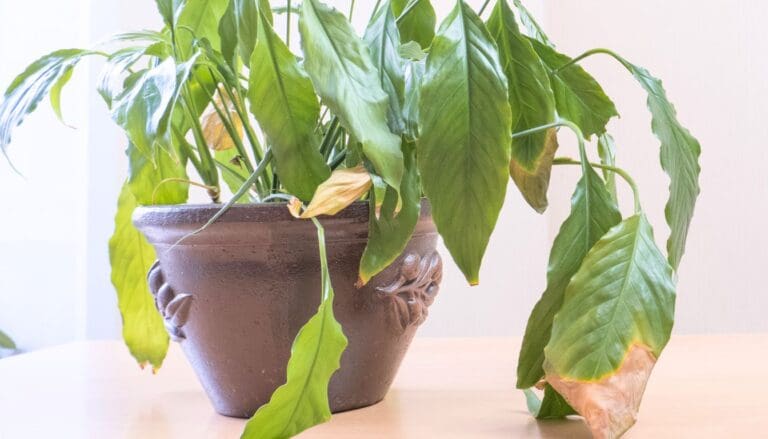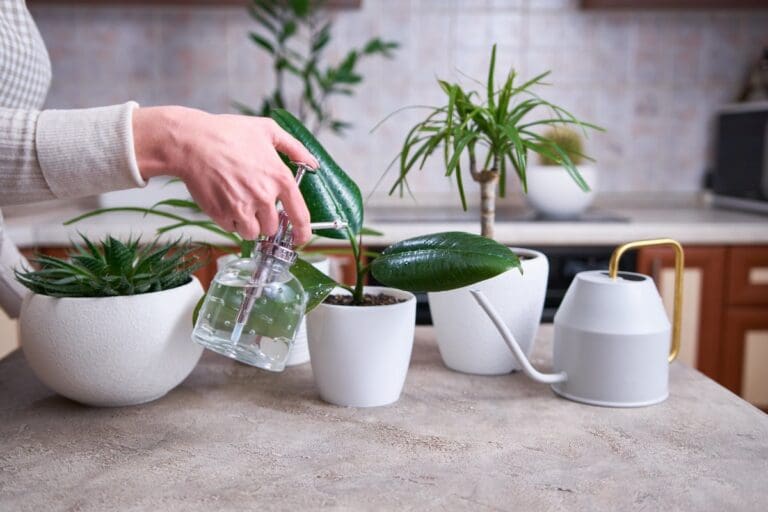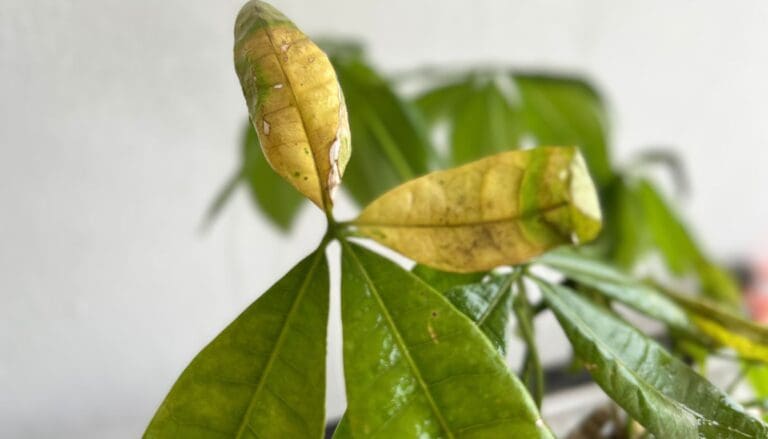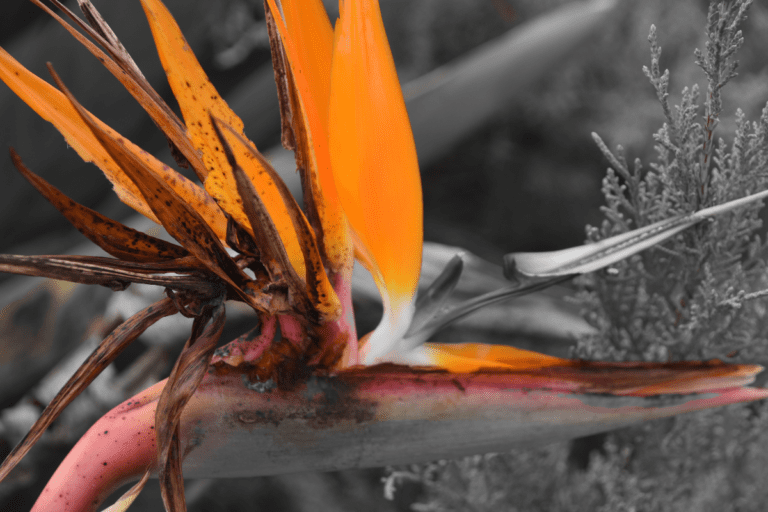What Kind Of Pot Is Good For Peperomia? (Size, Material & More)
If you want to keep your peperomia happy, you must not deny the importance of choosing the right pot. Although this might seem insignificant, if you give it a thought, you’ll understand that the health of your peperomia can depend a lot on its pot. Don’t worry if you don’t get it, as we’ll tell you how a pot can affect the health of peperomia.
Peperomia plants require anything but a large-sized pot! These plants will remain happy in a pot that fits its root balls well. As for the material, a terracotta or clay pot would be best as it supports air exchange between the roots and air. The pot you choose must contain drainage holes.
If you don’t make the correct choice while selecting a pot for your peperomia, it might develop different problems. If the pot size is too small, its growth will become restricted and root-bound.
If you use a large pot, the peperomia will get overwatered and develop root rot, fungus infection, and pest infestation.
With that being said, let’s understand how each of these factors can affect your peperomia plant – the size, the material, and the drainage system of the pot.

Please note: Simplify Plants is reader-supported. Some links in the post are affiliate links and I get a commission from purchases made through links in the post.
Factors to consider while selecting a pot for peperomia
When you are growing peperomia as a houseplant, it resides in the pot you select for it. If the pot is not suitable for the plant, it won’t be possible for the peperomia to remain healthy.
Therefore, you must consider these three factors while selecting a pot for your beloved peperomia plant.
- Size of the pot
- Material of the pot
- The drainage system of the pot
Now, let’s understand these in detail.
Size of the pot

The size of the pot can determine the growth of your peperomia plant. One unique thing about peperomia is that it likes to stay compact inside the pot.
The root system of the peperomia is shallow, so it takes time for these plants to become root-bound. That, however, doesn’t mean that you should select a small pot for your peperomia.
Hazards of choosing a small pot
Selecting a small pot will have these effects on your peperomia:
- Stunted growth
- Lack of nutrients
- Root-bound plant
- The plant will fall on one side if it becomes top-heavy.
Selecting a small pot will not allow the roots to grow, and without root growth, you won’t see growth in other parts of the plant either.
A small pot will hold less soil, and that will retain fewer nutrients. Therefore, the plant will run out of nutrients quickly if you keep it in a small pot.
The peperomia might also become root-bound if you keep it in a small pot. The roots start forming a bundle inside the pot and are unable to function correctly. These roots start displacing the soil due to a lack of space.
Also read: How Fast Does Peperomia Grow? (+Factors Affecting Growth)
Hazards of choosing a big pot
If you select a bigger pot thinking that you won’t need to repot the peperomia for many years and it can grow freely, you are making a mistake.
A large pot can come with these problems:
- Overwatering
- Root rot
- Droopy leaves
- Overgrowth
The most common problem of keeping your plants in a large pot is overwatering. It is natural to give more water when you have a large pot, but the plant will not require as much water, so it will get overwatered.
With overwatering comes one of the deadliest diseases found in plants, root rot. The roots start rotting due to sitting in the water for too long.
This makes the plant weak as the roots fail to absorb nutrients or water. It also makes the plant susceptible to pests and fungal infections.
When you have an overwatered or weak peperomia, you will notice signs like droopy leaves and discoloration of the leaves.
One more problem you might face if you keep your peperomia in a big pot is overgrowth. In a big pot, the plant will get more nutrients that will lead to more growth in the plant.
If the plant grows bigger than expected and becomes messy to look at, it will become a problem.
Material of the pot

There are many types of pots available in the market. It can be confusing to understand which would be best for your peperomia, but we are here to help.
There are two kinds of pots:
- Porous
- Non-porous
First, let’s understand the difference between porous and non-porous pots.
Porous pots have pores that allow air to flow between the pores. These are the best for houseplants as they let airflow inside the soil and the roots that keep them healthy.
Some examples of porous materials are clay, terracotta, and ceramic.
Non-porous pots don’t have any pores, so they do not allow air to flow inside them. The soil or roots do not get any airflow if you keep the plant in a non-porous pot.
Plastic pots are non-porous pots.
Although many people prefer to keep their plants in plastic pots, you can understand that going for a porous pot would be much more beneficial for the health of your peperomia.
Therefore, we suggest you select a terracotta, clay, or ceramic pot for your peperomia plant.
The drainage system of the pot
Most houseplants require a proper drainage system that comprises well-draining soil and a pot with drainage holes.
Peperomia plants prefer slight moisture in the soil. The soil will hold the required moisture and drain the excess water out of the pot’s drainage holes.
If the pot doesn’t have drainage holes, the excess water will remain in the soil, and you will face the following problems:
- Soggy soil
- Overwatering
- Droopy leaves
- Root rot
- Fungal infections
- Pest infestation
Without proper drainage holes, the peperomia will get overwatered even when you water it correctly.
Therefore, when getting a pot for your peperomia, ensure it has drainage holes that can let the excess water drain out of the system after you water the plant.
If the pot doesn’t have drainage holes, you can make one yourself.
How to make drainage holes in the pot?
You can make one or more drainage holes in your pot with few steps.
Supplies you will need:
- Water
- Spray bottle
- Marker
- Nail
- Drill
If you want to make a drainage hole on an unglazed pot, you must soak it overnight. This will allow the drill to move smoothly.
- First, mark the spot or spots where you want to make drainage holes with a marker.
- You can use a nail to keep the drill in place.
- You can keep a spray bottle handy to make the surface wet with the spray bottle that will make the drilling easy.
- Make sure to drill at a 90-degree angle to the pot.
- If you feel that you cannot make the holes properly, use a bit more force.
Sometimes, the drainage holes can get blocked that will restrict the flow of the water. You can put some pebbles in the pot before adding the soil to prevent the blockage of the holes.
Keep a cache tray below the pot for the excess water to get collected after watering. Empty the cache tray after it collects some water.
What is the ideal pot for peperomia?

Now that you know all the factors you need to consider while selecting a pot for your peperomia, you can finally go and get one.
When you buy a houseplant, it usually comes in a plastic pot with drainage holes. Sometimes it comes in ornamental pots that don’t have drainage holes.
It would be best for you to repot these plants in a pot with drainage holes. You can choose a plastic pot, but we recommend that you go for a clay or terracotta pot.
Make sure that the pot has drainage holes. Choose a size that is one size bigger than the size of your peperomia plant.
To sum up the whole thing, the ideal pot of your peperomia should:
- Have one or more drainage holes
- Be one size bigger than the size of your peperomia
- Be of a porous material
When to repot a peperomia?

Peperomia is a slow-growing plant that doesn’t need frequent repotting. As a rule of thumb, you must repot your houseplants after every 2-3 years.
You can follow that for your peperomia, but we suggest that you repot this plant when it becomes root-bound.
Peperomia is compact and likes to remain slightly root-bound. However, when you start seeing the roots coming out of the drainage holes, you must not wait and repot the plant as soon as you can.
Signs that your peperomia requires repotting
Take a look at these signs and consider repotting your peperomia if you come across any of these.
- Water runs out of the pot immediately after you water it.
- Roots are coming out of the drainage holes.
- The pot looks bulged or develops cracks.
- The roots have started forming a bundle inside the pot.
- Stunted growth.
Go for a size that is larger than the current pot.
Spring would be the best time for repotting your peperomia as it is the growing season when the plant can adjust to the changes with the least stress.
You must repot your peperomia in other cases, such as when it is overwatered and has root rot, infected with a fungal disease, or infested by pests.
If you feel that the soil has lost its quality and cannot provide enough nutrients to the plant even after fertilizing it correctly, you can repot the plant with a fresh soil mix. A sign of this problem might be stunted growth in your peperomia.
Also read: Do Peperomia Like To Be Root Bound? (+When To Repot)
Final words

Choosing the correct pot can affect the health of your peperomia plant immensely. Take a quick look at these tips that can help you keep your peperomia healthy.
- After bringing your peperomia home, choose a pot as deep as the container that the plant came in. Don’t go for a deeper pot, as that can stress the plant.
- For repotting your peperomia, choose a pot one or two inches larger than the current pot.
- Use a potting mix that has some chunky materials that make it light and well-draining.
- Make drainage holes if your pot doesn’t have one.
- Use a porous pot so that the soil and roots remain well-aerated.
- Use a cachepot, water-absorbing mat, or a container to drain the excess water from the drainage holes. This will not damage the surface.
Ref: University of Florida, Sage Journal, University of Vermont, New Jersey Agricultural Experiment Station
Rutgers, The University of Arkansas, Britannica, Wikipedia, Peperomia Diseases, NC State University.
Recommended Garden Supplies
| Product Image | Our Recommended Gardening Supplies | Check Offers! |
|---|---|---|
Top Top
Top
Top
Top
Top
Top
Top
Top | rePotme Houseplant and Tropical Classic Potting Soil Mix | Check Offer On Amazon |
 Top
Top
Top
Top
Top
Top
Top
Top | Espoma Organic Indoor Plant Food | Check Offer On Amazon |
 Top
Top
Top
Top
Top
Top
Top
Top | GooingTop LED Grow Light 6000K Full Spectrum Clip Plant Growing Lamp | Check Offer On Amazon |
 Top
Top
Top
Top
Top
Top
Top
Top | Soil Moisture Meter | Check Offer On Amazon |
 Top
Top
Top
Top
Top
Top
Top
Top | Govee Hygrometer Thermometer, Bluetooth Enabled! | Check Offer On Amazon |
 Top
Top | LEVOIT Humidifiers for Large Room(Best For Plants) | Check Offer On Amazon |
 Top
Top
Top
Top
Top
Top
Top
Top | Upgraded DIY Automatic Drip Irrigation Kit, 15 Potted Houseplants Support | Check Offer On Amazon |
 Top
Top
Top
Top
Top
Top
Top
Top | Stainless Steel Heavy Duty Gardening Tool Set | Check Offer On Amazon |
 Top
Top
Top
Top
Top
Top
Top
Top | Bonide Insecticidal Soap | Check Offer On Amazon |
 Top
Top
Top
Top
Top
Top
Top
Top | Bonide 32 oz Spray Neem Oil for Organic Gardening | Check Offer On Amazon |
 Top
Top
Top
Top
Top
Top
Top
Top | Garden Safe Fungicide | Check Offer On Amazon |






